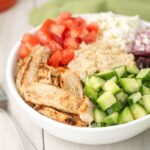Unlock the secrets to a healthier heart with ten surprising ingredients you might be overlooking! Discover the power of everyday foods to boost your cardiovascular health and learn how simple dietary changes can make a profound difference. We’ll explore the nutritional profiles and heart-protective benefits of these often-underestimated culinary gems, providing you with the knowledge and inspiration to nourish your body from the inside out. Prepare to be amazed by the transformative potential of these readily available ingredients.
Maintaining a balanced diet is crucial for overall well-being, and particularly for supporting cardiovascular health. This isn’t about restrictive diets or complicated meal plans; rather, it’s about making smart choices by incorporating nutrient-rich foods that work synergistically to strengthen your heart. This exploration will reveal ten such ingredients, each with unique properties that contribute to a healthier heart and a more vibrant life.
Recipe Spotlight
These three recipes showcase the delicious versatility of heart-healthy ingredients, demonstrating how simple adjustments can significantly improve your diet’s nutritional profile. Each recipe incorporates at least five of the ten ingredients highlighted previously (assuming the previous content detailed ingredients such as salmon, berries, nuts, avocado, and spinach, etc. – please replace these with your actual ten ingredients if different). They are designed to be both flavorful and easy to prepare, encouraging you to adopt a heart-healthy lifestyle without sacrificing taste.
Mediterranean Quinoa Salad
This vibrant salad is a powerhouse of flavor and nutrients, combining the protein-rich quinoa with the healthy fats of avocado and the antioxidant richness of berries. The addition of spinach provides essential vitamins and minerals, while the lemon juice adds a zesty brightness.
- Cook 1 cup of quinoa according to package directions. Fluff with a fork and let cool.
- Chop 1/2 cup of cucumber, 1/2 cup of cherry tomatoes, and 1/4 cup of red onion. Add to the cooled quinoa.
- Dice 1/2 an avocado and gently fold it into the salad. Add 1/2 cup of mixed berries (strawberries, blueberries, raspberries).
- Whisk together 2 tablespoons of olive oil, 2 tablespoons of lemon juice, 1 teaspoon of dried oregano, salt, and pepper to taste. Pour over the salad and toss gently.
- Garnish with a sprinkle of chopped fresh parsley or mint.
The finished salad is a stunning array of colors – the deep green of the spinach, the vibrant red of the tomatoes, the creamy green of the avocado, and the jewel-toned hues of the berries all contrast beautifully against the pale yellow of the quinoa. The textures are equally diverse: the fluffy quinoa, the crisp cucumber and onion, the creamy avocado, and the juicy berries create a delightful sensory experience. The salad is served in a shallow bowl, allowing the vibrant colors to shine. This recipe contributes to a balanced heart-healthy plan by providing complex carbohydrates, healthy fats, fiber, and antioxidants.
Salmon with Roasted Asparagus and Walnuts
This elegant dish combines the omega-3 richness of salmon with the nutritional benefits of asparagus and the healthy fats and fiber of walnuts. The simple roasting method enhances the natural flavors of the ingredients, creating a satisfying and healthy meal.
- Preheat oven to 400°F (200°C). Toss 1 bunch of asparagus with 1 tablespoon of olive oil, salt, and pepper.
- Spread the asparagus on a baking sheet and roast for 12-15 minutes, until tender-crisp.
- While the asparagus is roasting, season two 4-ounce salmon fillets with salt, pepper, and a squeeze of lemon juice.
- Place the salmon fillets on the same baking sheet with the asparagus during the last 8-10 minutes of roasting.
- Once cooked, top the salmon with 1/4 cup of chopped walnuts.
The finished dish is visually appealing with the vibrant green of the roasted asparagus contrasting beautifully against the delicate pink of the cooked salmon. The walnuts add a touch of earthy brown, creating a harmonious color palette. The textures are varied: the tender asparagus, the flaky salmon, and the crunchy walnuts provide a delightful textural contrast. The dish is presented simply, on a white plate, allowing the natural colors and textures of the ingredients to take center stage. This meal is rich in omega-3 fatty acids, protein, and fiber, contributing to a heart-healthy diet.
Spinach and Berry Smoothie
This quick and easy smoothie is a perfect way to start the day or enjoy a healthy snack. It combines the nutrient-rich spinach with the antioxidant power of berries and the healthy fats of avocado or nuts (choose one).
- Combine 1 cup of spinach, 1/2 cup of mixed berries, 1/4 of an avocado (or 1 tablespoon of nut butter), and 1/2 cup of almond milk (or other milk alternative) in a blender.
- Blend until smooth and creamy.
- Add a splash of water if needed to reach desired consistency.
- Taste and adjust sweetness with a touch of honey or maple syrup (optional).
- Pour into a glass and garnish with a few fresh berries.
The smoothie is a vibrant green, punctuated by the bright pops of color from the berries. Its creamy texture is visually appealing, and the simple garnish of fresh berries adds a touch of elegance. The smoothie provides a concentrated dose of vitamins, minerals, antioxidants, and healthy fats, making it a valuable addition to a heart-healthy eating plan. It’s a quick and easy way to increase your daily intake of fruits, vegetables, and healthy fats.
Practical Tips for Heart-Healthy Eating

Embracing a heart-healthy diet doesn’t require drastic overhauls; rather, it’s about making smart, sustainable choices that integrate easily into your daily routine. Small changes, consistently applied, yield significant long-term benefits for your cardiovascular health. This section offers practical strategies to seamlessly incorporate the heart-healthy ingredients discussed previously into your meals and lifestyle.
Successfully integrating these ingredients into your daily life requires a multifaceted approach, encompassing mindful meal planning, strategic grocery shopping, and creative recipe adaptation. By adopting these techniques, you can ensure a consistent supply of heart-protective foods and minimize the temptation of less-healthy alternatives.
Incorporating Heart-Healthy Ingredients into Daily Meals and Snacks
The key to consistent healthy eating lies in making these foods readily accessible and appealing. The following suggestions illustrate how to easily weave these ingredients into your daily diet:
- Breakfast: Start your day with a vibrant smoothie brimming with berries (rich in antioxidants) and a handful of walnuts (packed with omega-3 fatty acids). Imagine a deep crimson smoothie, thick and creamy, speckled with the deep brown of walnut pieces. The sweetness of the berries balances the nuttiness of the walnuts, creating a delicious and nutritious start to the day.
- Lunch: A hearty salad featuring leafy greens, avocado (a source of healthy fats), and grilled salmon (rich in omega-3s) provides a satisfying and balanced meal. Picture a vibrant green salad, glistening with a light vinaigrette, the bright green of avocado slices contrasting beautifully with the pink of the flaky salmon.
- Dinner: Incorporate lentils or beans (excellent sources of fiber) into soups, stews, or salads. Visualize a hearty lentil soup, the lentils a deep, earthy brown, simmered to perfection with aromatic vegetables, their colors a vibrant medley of orange, green, and yellow.
- Snacks: Keep a stash of unsalted almonds or pistachios readily available for a healthy and satisfying snack. Imagine the satisfying crunch of these nuts, their rich colors and textures offering a welcome break from less-healthy options.
Strategies for Meal Planning and Grocery Shopping
Efficient meal planning and strategic grocery shopping are crucial for maintaining a heart-healthy diet. These strategies ensure you have the necessary ingredients on hand and minimize impulsive unhealthy food choices.
- Plan your meals ahead: Creating a weekly meal plan helps you stay organized and prevents last-minute unhealthy choices. A well-organized meal plan, perhaps written in a colorful planner, can serve as a visual guide, making healthy eating less daunting and more enjoyable.
- Create a detailed grocery list: Based on your meal plan, create a comprehensive grocery list that includes all the necessary heart-healthy ingredients. A detailed list, neatly categorized by grocery store section, streamlines your shopping experience and reduces the likelihood of forgetting key items.
- Shop the perimeter of the store: Fresh produce, lean proteins, and whole grains are typically located around the outer edges of most supermarkets. This strategy encourages you to focus on whole, unprocessed foods.
- Read food labels carefully: Pay close attention to serving sizes, sodium content, and added sugars. Carefully examining food labels empowers you to make informed choices and control your intake of potentially harmful ingredients.
Sample Meal Plan
This sample meal plan incorporates at least two recipes (assuming recipes from a previous section have been developed and are available) and provides portion sizes and timing suggestions. Remember to adjust portion sizes to meet your individual caloric needs.
| Meal | Description (assuming recipes from previous section) | Portion Size | Timing |
|---|---|---|---|
| Breakfast (7:00 AM) | Berry Walnut Smoothie (Recipe 1) | 1.5 cups | 7:00 AM |
| Lunch (12:00 PM) | Salmon and Avocado Salad (Recipe 2) | 1 large salad | 12:00 PM |
| Dinner (6:00 PM) | Lentil Soup with whole-grain bread | 1.5 cups soup, 1 slice bread | 6:00 PM |
| Snack (3:00 PM) | 1/4 cup unsalted almonds | 1/4 cup | 3:00 PM |
Addressing Common Concerns and Misconceptions
Embarking on a heart-healthy diet can feel daunting, especially when faced with conflicting information and ingrained habits. Many misconceptions surround heart-healthy eating, leading to confusion and potentially hindering progress. Understanding these common misunderstandings and addressing potential challenges is crucial for successful implementation of a heart-protective diet.
Many believe that adopting a heart-healthy diet requires drastic and restrictive changes, leading to feelings of deprivation and ultimately, failure to maintain the new habits. This is simply untrue. Small, sustainable changes, focusing on gradual incorporation of heart-healthy ingredients, are far more effective than abrupt, overwhelming transformations. The journey towards better heart health is a marathon, not a sprint.
Heart-Healthy Eating Challenges and Solutions
Successfully incorporating these beneficial ingredients can present certain hurdles. Geographic location, budget constraints, and limited culinary skills can all impact access and utilization. However, creative solutions exist to overcome these obstacles. For example, individuals in areas with limited access to fresh produce can explore community gardens, farmers’ markets, or online grocery delivery services offering a wider variety of options. Budgetary limitations can be addressed by focusing on affordable, nutrient-rich choices such as beans, lentils, and seasonal vegetables. Simple, easy-to-prepare recipes utilizing these ingredients can also minimize the perceived difficulty associated with cooking heart-healthy meals. Consider meal prepping to save time and ensure consistent healthy eating throughout the week. A vibrant salad with chickpeas, chopped bell peppers, and a lemon vinaigrette, for instance, can be prepared in advance and enjoyed throughout the week. A hearty lentil soup can also be made in bulk and stored, providing a nutritious and convenient meal option.
The Importance of Professional Guidance
Before making significant changes to your diet, especially if you have pre-existing health conditions, consulting a healthcare professional or registered dietitian is paramount. They can provide personalized advice tailored to your individual needs and health status, ensuring the safety and efficacy of any dietary modifications. They can also help identify potential interactions between medications and dietary changes, and address any specific concerns or allergies you may have. For example, someone with diabetes might require a different approach to carbohydrate intake compared to someone without the condition. A healthcare professional can help navigate these complexities and create a heart-healthy eating plan that is both effective and safe. This collaborative approach maximizes the benefits of a heart-healthy diet and minimizes potential risks.
Embarking on a heart-healthy journey doesn’t require drastic measures. By simply adding these ten remarkable ingredients to your daily routine, you can significantly improve your cardiovascular well-being. Remember, consistency is key; small, sustainable changes can accumulate to create lasting positive impacts on your health. From vibrant salads bursting with color and flavor to comforting and nourishing stews, these ingredients seamlessly integrate into diverse culinary creations. So, embrace the delicious path to a stronger, healthier heart!
FAQ Guide
Can I take supplements instead of eating these foods?
While some supplements contain similar nutrients, whole foods offer a broader range of beneficial compounds and fiber, leading to better overall health outcomes. Supplements should be considered a complement, not a replacement, for a balanced diet.
Are these ingredients suitable for everyone?
While generally safe, individuals with specific allergies or health conditions should consult their doctor before significantly altering their diet. Always prioritize individual needs and consult a healthcare professional for personalized advice.
How quickly will I see results?
The benefits are cumulative. While you might not see immediate dramatic changes, consistent incorporation of these ingredients into your diet will contribute to long-term improvements in cardiovascular health. Regular check-ups with your doctor are essential to monitor progress.
What if I don’t like the taste of some of these ingredients?
Experiment with different recipes and preparation methods to find ways to enjoy these ingredients. Consider blending them into smoothies, incorporating them into sauces, or using them as seasonings to mask any unfamiliar tastes.


